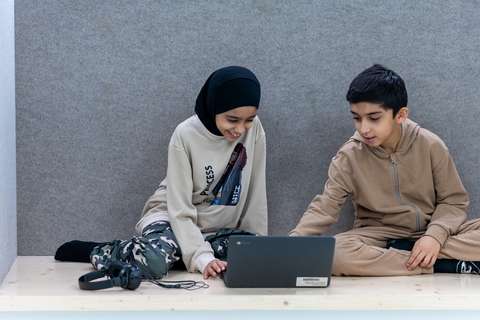AI literacy is a civic skill that belongs to everyone on the learning path in Espoo
AI is currently a hot topic among adults, children and the youth alike. The constantly evolving applications and uses of artificial intelligence are spreading to our everyday lives, partly without us even noticing. Artificial intelligence is employed when, for example, we see an ad on social media, order a product online, launch our robot vacuum cleaner using an app, ask a chatbot for help or use a search engine in a browser.
On the path to education and growth and in accordance with the curriculum, we teach children and youth to act safely, responsibly and innovatively in the digital world. Through practice, children and youth learn to identify when they are using artificial intelligence in their daily lives and how artificial intelligence works. AI literacy is a civic skill included in the studies of children and youth in Espoo.
Schools ensure that pupils and students have an understanding of AI. Media literacy is important because children and young people must be able to compare information from different sources, critically assess credibility, and recognise what AI be used for. Schools continuously work on ensuring that the AI literacy of staff engaged in teaching is up to date and making sure that they are able to cover both opportunities and risks of AI. Being able to identify risks and considering data protection is important for children and youth. They should not, for example, give the AI names, addresses or other personal information, such as health data.
AI use in Espoo schools and upper secondary schools is controlled and guided
The education sector uses data protection controlled programs with AI-assisted features. In digital learning environments, pupils and students can complete assignments that explain concepts and provide feedback. The Immersive Reader AI can give feedback and tips to e.g. a pupil reading out loud. Teachers can use AI tools to create multiple choice assignments, quizzes and other assignments.
“The goal is that children and youth learn to prompt AI to help them learn better. For example, they can ask artificial intelligence to explain a difficult term in plain language. It is important for the pupils to understand that there is no person behind artificial intelligence, but rather a language model that combines words according to the prompt,” explains Minna Kukkonen, Pedagogical Specialist in Learning Technology in Espoo.
The City of Espoo is responsible for the safety of AI services for children and youth
The introduction of AI services involves issues related to both the EU’s General Data Protection Regulation and the AI Regulation, and the City of Espoo ensures compliance. For example, it must be ensured that data is processed securely and that the data entered by City of Espoo users is not used for AI training. In addition, AI tools may have age restrictions that limit their use in teaching.
“We aim to introduce a GPT-based tool in lower and upper secondary schools as part of the current digital learning environment as soon as it is secure. GPT language models can be used, for example, for brainstorming, producing or editing text, translating, and using AI as a personal assistant. We are investigating other use cases for AI and are planning a curriculum bot. The aim is that the AI bot would help with curriculum-related questions,” says Harri Luttinen, Digital Development Manager.
